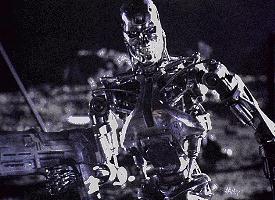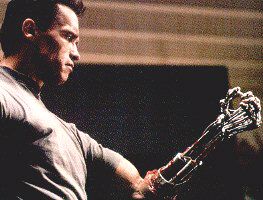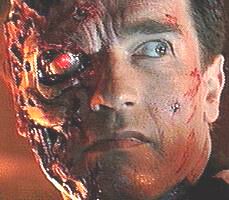





Manufacture and mechanics of Cyberdyne Systems design cybernetic organisms, or the T-800 model Terminator infultration unit, and how it works.
The T-800 is a neural net microprocessor controlled titanum alloy endoskeleton with infra red night vision mini-cameras for eyes, surrounded by artificially grown living tissue.
The T-800 can operate uninterupted for 120 years with it's existing power cell, and has a limited self repair capacity, by bypassing damaged circuits and/or accesing an alternate power supply. It can also manually repair itself, and conduct surgery apon it's skin, or apon a human being with it's detailed anatomic files.
Other software capabilities include, image enhancement, voice synthesis, computer targeting, 3-D wireframe surface scan, character recognition, as well as several instructional guides on all relevant skills (I.E. how to dial a phone, hotwire and drive a car, fire all known guns, how to put on clothing, how to get coins out of a payphone, how to follow maps, participate in close hand to hand combat, wield melee weapons, etc, etc..).
Skynet sets the pin switch on all T-800 CPUs to read mode to prevent any
possible independant thought, and thus keep them under control.
Setting the
switch to read/write mode allows a T-800 to learn, and possibly develop it's own
consciousness.
Organic tissue, and life support -
(Here I decided to trim the searching, and rambling, and dead end speculations from this one, and just cut right to my final conclusions).
Nutrient processors encased within the endoskeleton dissolve oxygen and nutrition directly into the bloodstream of the organic skin with needleless micro injectors from small access hatches on the endoskeleton's surface (remember, Terminators don't eat).
The T-800 can sustain the skin for the endoskeleton's 120 year powercell
lifetime with just a small amount of raw super-concentrated
nutrition.
These injectors also infuse coagulants and healing
booster agents.
This is why the skin is incapable of dying from severe blood
loss incurred by radical tissue trauma, as it indeed doesn't bleed much at all.
A percentage of waste is expelled through the sweat glands.
The remainder
(residual blood born urea, and dead cells) is filtered out of the blood with a
similar needleless process linked to a mechanical kidney, chemically digested,
and distilled and evaporated down to dust.
This chemically oblilerated waste
dust equals the aproximate mass of the raw nutrition.
The removed waste, and the nutrients are contained in small specialized and seperated containers.
Water, lost mostly through sweating, is reclaimed from the atmosphere by moisture condensers in the endoskeleton's mouth and nostrils (the only external orifaces available for such decices).
Control of lips, facial expression, and body muscles, as well as the ability to sense damage to the dermal layer (to quote Ahnuld "my system senses damage, the data could be called pain") is due to endoskeletal external contact electrode interfaces to the organic nervous system.
Tissue fabrication -
As shown in the teaser trailer for T2, the skin is instantly injected by a mold over the endoskeleton.
This mold injects artificially grown stem cells, and triggers them into specializing into the right tissue cells, in the proper distributions, with a microscopicly precise chemical lythographic printer wich lays the right drug trails for the right tissues, thus clumping the cells together all at once into the completly developed endo-skin.